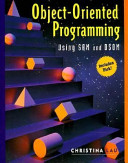Object-Oriented Programming Using SOM and DSOM: Difference between revisions
No edit summary |
No edit summary |
||
| Line 1: | Line 1: | ||
[[image:SOM-DSOM-Lau.jpg]] | [[image:SOM-DSOM-Lau.jpg]] | ||
==Description== | |||
It provides a language-neutral environment for building object-oriented class libraries. It promotes optimum software reuse and features multiple language bindings that enhance bridge-building between object-oriented and procedural languages. Totally CORBA compliant, it represents a viable strategic solution to multiplatform, multivendor computing-providing transparent access to objects distributed across different address spaces on different machines. It is IBM's System Object Model (SOM), a remarkable new paradigm for developing and packaging object-oriented software on AIX/6000, OS/2, and Windows. In this new hands-on guide, programmers, system architects, and managers will discover exactly what SOM is and learn how it can best be used to design and implement object-oriented applications. Written in a clear, lucid style, Objected-Oriented Programming Using SOM and DSOM first delivers a global overview of SOM, clarifying the basic steps involved in creating SOM objects, and profiling the complete SOM system - exploding classes, metaclasses, inheritance, and method-resolution. From here, the guide shows how SOM complements C++ and breaks new ground in such important areas as Distributed Objects, Persistence Objects, and Replication. | It provides a language-neutral environment for building object-oriented class libraries. It promotes optimum software reuse and features multiple language bindings that enhance bridge-building between object-oriented and procedural languages. Totally CORBA compliant, it represents a viable strategic solution to multiplatform, multivendor computing-providing transparent access to objects distributed across different address spaces on different machines. It is IBM's System Object Model (SOM), a remarkable new paradigm for developing and packaging object-oriented software on AIX/6000, OS/2, and Windows. In this new hands-on guide, programmers, system architects, and managers will discover exactly what SOM is and learn how it can best be used to design and implement object-oriented applications. Written in a clear, lucid style, Objected-Oriented Programming Using SOM and DSOM first delivers a global overview of SOM, clarifying the basic steps involved in creating SOM objects, and profiling the complete SOM system - exploding classes, metaclasses, inheritance, and method-resolution. From here, the guide shows how SOM complements C++ and breaks new ground in such important areas as Distributed Objects, Persistence Objects, and Replication. | ||
==Online / Download== | ==Online / Download== | ||
Revision as of 17:14, 20 July 2014
Description
It provides a language-neutral environment for building object-oriented class libraries. It promotes optimum software reuse and features multiple language bindings that enhance bridge-building between object-oriented and procedural languages. Totally CORBA compliant, it represents a viable strategic solution to multiplatform, multivendor computing-providing transparent access to objects distributed across different address spaces on different machines. It is IBM's System Object Model (SOM), a remarkable new paradigm for developing and packaging object-oriented software on AIX/6000, OS/2, and Windows. In this new hands-on guide, programmers, system architects, and managers will discover exactly what SOM is and learn how it can best be used to design and implement object-oriented applications. Written in a clear, lucid style, Objected-Oriented Programming Using SOM and DSOM first delivers a global overview of SOM, clarifying the basic steps involved in creating SOM objects, and profiling the complete SOM system - exploding classes, metaclasses, inheritance, and method-resolution. From here, the guide shows how SOM complements C++ and breaks new ground in such important areas as Distributed Objects, Persistence Objects, and Replication.
